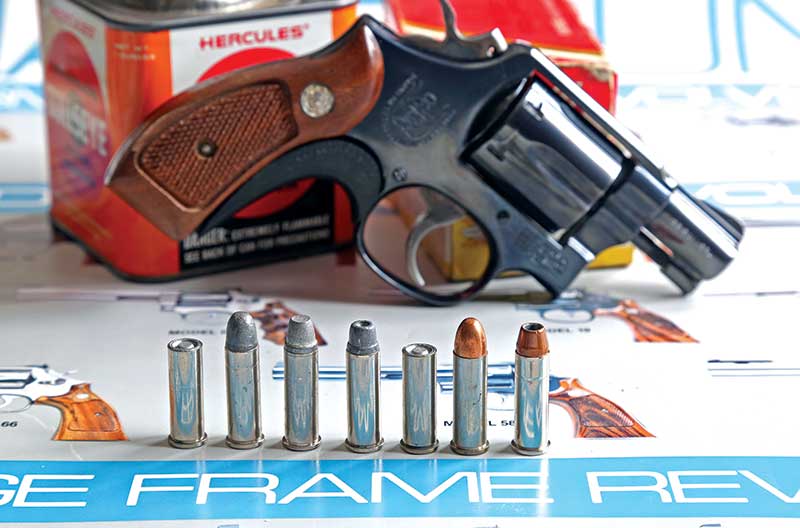.38 Wadcutters
Vs. .22 Magnum?
I’m probably the last person to notice, but .22 rimfire ammunition has become awfully expensive, assuming you can find it at all. How could I not have noticed earlier? Well, I bought my .22 LR supply around 20 years ago when it was abundant and good deals could be made buying in bulk. I haven’t bought .22 LR ammunition in years.
What got my attention was trying to find .22 Magnum ammunition. It’s my favorite cartridge for pest control around the farm. A couple hundred rounds gets me through the year. A couple of cartons picked up on sale lasted me four or five years. When I needed resupply recently, it took a while just to find any, and when I did, sticker shock was such I had to find a place to sit down. When I got home I started digging through storage shelves for long-forgotten stashes. Among the rediscovered treasures were thousands of .38 Special cases and several boxes of .38 Special wadcutter target ammunition. An alternative idea came to mind.
Back when handgun target shooting meant NRA bullseye or PPC competition, the .38 Special ruled. Millions of factory and handloaded wadcutters were used. A “wadcutter” is a cylindrical bullet with a flat, square nose. It cuts a clean, round bullet hole on paper, easy to score. Wadcutters can clearly cut the line of a higher scoring ring and in a sport where matches are won or lost by a single point, this matters.
Classic Load
For years, the working load was a soft lead, cast or swaged 148-gr. HBWC (hollow base wadcutter) and 2.7 gr. of Bullseye. Typically the velocity in 6″ revolver barrels, or in the 5″ barrel of the much-admired S&W 52 semi-auto pistol, was around 750–800 fps.
The large hollow base expanded from the gas pressure to tightly engage the rifling, enhancing accuracy. For the target shooter this load had it all; extreme accuracy, soft recoil and low cost.
Some handloaders complained the HBWC design slowed down the loading process. The sharp, square edge of the base means bullets don’t start into the case mouth easily. Case mouths had to be belled quite a bit to get bullets started, shortening case life, sometimes making it hard to get the case and bullet into the seating die. One solution was the beveled-base wadcutter (BBWC). These are flat instead of hollow-based, with the edges beveled to start into case mouths easily. For progressive reloaders with an automated bullet feed, the double-end wadcutter (DEWC) was designed, simply a cylinder beveled on each end. With these either end can be started into the case mouth.
Safety Tip
Reloading safe ammunition always requires vigilance and attention to detail, never more so than when reloading small powder charges in relatively large cases. Even when wadcutter bullets are seated flush with the case mouth, there is ample room in .38 Special cases for two or even three powder charges.
Pressure is also increased by deep seating of bullets. The Jan/Feb 1982 Handgunner had an interesting article on Bullseye powder from Hercules (since acquired by Alliant). The article debunked myths about “detonation” and mysterious “pressure excursions” with the classic 2.7-gr. Bullseye load.
The entire article is worth reading. I found a bit of info about pressure vs. seating depth especially useful. “Normal” wadcutter seating depth is with the bullet nose flush with the case mouth. With a 2.7-gr. load of Bullseye, normal seating depth showed a pressure of 8,700 psi. At 1/8″ deeper, 16,100 psi.
Going to 5.4 grs. (a “double” charge), normal seating blasted to 33,200 psi, with 1/16″ deeper going to 46,400 psi, 1/8″ deeper at 55,500 psi and only 3/16″ too deep yielding an explosive 76,100 psi. Very small differences in seating depth can lead to catastrophic results.
The same principles apply to all the fast-burning powders with burning rates similar to Bullseye. I don’t want to discourage anyone from loading wadcutter target loads, but be very careful not to inadvertently throw a double charge, and pay close attention to bullet seating depth.
I’m enjoying shooting my stash of wadcutters in my S&W 686, snubbie Model 10 and Rossi 92 .357 carbine. With the carbine I have to single-load rounds as they don’t feed reliably, but with their soft recoil and extreme accuracy they are fun to shoot. And if my supply of .22 Magnum gets too low I know these .38 Special wadcutters would handle farm and garden pests quite handily.







